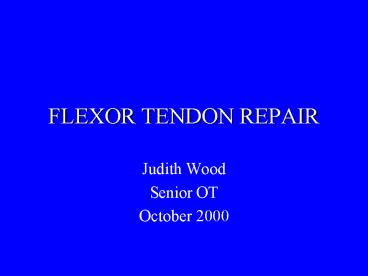FLEXOR TENDON REPAIR - PowerPoint PPT Presentation
1 / 13
Title:
FLEXOR TENDON REPAIR
Description:
Restoring normal function after flexor tendon injury.and repair. ... Aoki et al (1997) Canine flexor tendons subjected to active-passive mobilization ... – PowerPoint PPT presentation
Number of Views:2617
Avg rating:3.0/5.0
Title: FLEXOR TENDON REPAIR
1
FLEXOR TENDON REPAIR
- Judith Wood
- Senior OT
- October 2000
2
Revision Which structures produce flexion of the
IP joints? What is the purpose of the flexor
tendon sheath? What components make up the flexor
sheath? How do they differ and why? What
biomechanical significance does the pulley system
have? How do flexor tendons receive their
nutrition? How do flexor tendons heal?
3
Aim of treatment
Restoring normal function after flexor tendon
injury.and repair.
4
- What complications are likely to arise following
tendon repair? - Restrictive adhesions.
- Inflammation/oedema.
- Disruption of the tendon sheath.
- Infection.
- Rerupture.
- Patient compliance.
5
Characteristics of an ideal flexor tendon repair
Strickland JW.(1995)
- Sutures easily placed in the tendon.
- Secure suture knots.
- Smooth juncture of tendon ends.
- Minimal gapping of tendon ends.
- Minimal interference with tendon vascularity.
- Sufficient strength to permit early stress.
6
The Development of Active Mobilization.
- Studies by Kleinert et al (1967), and Strickland
and Glogovac (1980), amongst others, indicated
that active movement produced greater tendon
excursion than passive movement.
7
Silfverskiöld (1993) Demonstrated variations of
tendon gliding amongst individuals and concluded
restrictive adhesions were more likely to develop
in the absence of gliding.
Aoki et al (1997) Canine flexor tendons subjected
to active-passive mobilization maintained greater
strength than those which were immobilized.
Kleinert (1967) developed the active
extension/passive flexion protocol. Modified by
Slattery and McGrouther (1984).
8
Strickland (1980) preferred passive flexion and
passive extension and introduced the hinged wrist
splint.
Small et al (1989) developed the Belfast Regime
of early active mobilization, widely recognized
and used today.
Laboratory and clinical studies have shown that
stronger suture techniques can withstand the
strain of immediate active motion without a
significant risk of tendon rupture or gap
formation. (Taras and Lamb, 1999.)
9
Application of active-passive mobilization.
Several protocols have been described (Allen
1988, Cullen 1993 and Gratton 1993.) Each
suggests splinting the wrist and MCP joints in
some degree of flexion and introducing gentle
active digital motion over a 6-week period within
the splint.
10
Post-operative management at Blackburn Royal
Infirmary
- We currently follow the Belfast Regime.(Small et
al.,1989) - Dorsal blocking splint with the wrist at
approximately 30 degrees MCPs at 60 or 70
degrees and the IP joints at neutral. - Active mobilization is best begun at 3 or 4 days
post op. (maybe initiated sooner depending on
pain or oedema, but not later)
11
- Following the removal of sutures, patients are
instructed on how to care for their scar. - Protected mobilization is progressed and
continued for 6 weeks. - Once the splint is removed light functional
activity is encouraged and progressed in terms of
resistance as the tensile strength of the
repaired tendon increases.
12
- Factors which influence outcome.
- Peck et al (1998) stated the following
contributing factors - Compliance and patient attendance
- Multiple tendon damage
- Grade of surgeon
- Type of suture and suture material
13
Conclusions. EBP relating to flexor tendon
repair must follow a specific protocol e.g. the
Belfast Regime. However, outcome is influenced by
many factors and so each individual must be
treated appropriately using clinical reasoning to
complement evidence base.































